Blocks
A block is a portable pulley, made of wood, metal, or wood and metal.
Parts of a block
The main parts of a block are the shell or body; the sheave or wheel over which the rope runs; the pinon which the sheave turns; the bush or bearing between the sheave and the pin; and the eye, hook, strop or other fitting by which the block is secured in the required position.
The top of the block where the eye or hook is fitted is called the crown; the bottom of the block is the arse or tail; the sides of the shell are the cheeks, and the groove made in the cheeks of some blocks to take the strop is called the score; the opening between the sheave and shell through which the rope passes is the swallow; and the eye sometimes fitted at the tail is the becket.
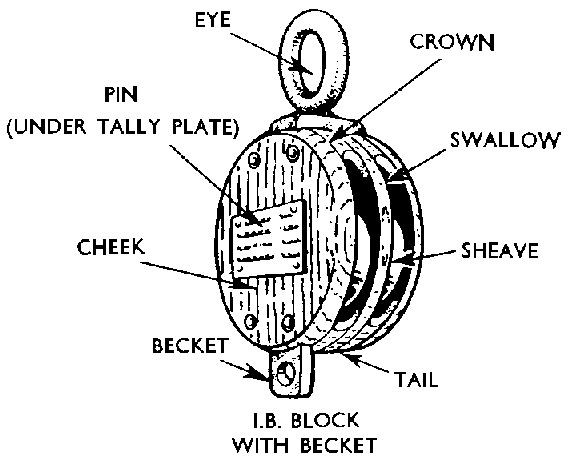
[ FIG. 1. Parts of a block ]
Classification of blocks
Wooden blocks are classified by their size, which is their length from crown to tail measured round the shell; an ordinary wooden block will take a rope one-third of its size, so that a 9-inch block, for example, would be required for a 3-inch rope. Metal blocks are classified by the size of rope for which each is designed, which is marked on a plate affixed to one cheek. Blocks may have more than one sheave; a single block has one sheave, a double block two, a triple block three, and so on.
Types of block
Internal-bound (I.B.) block. This block has a shell partly of wood and partly of metal, and is the modern type of wooden block. The metal portion consists of a fork-shaped steel fitting, called the binding, which incorporates both the eye or hook and the becket when fitted; it also takes the pin of the sheave. The wooden portion, which is of elm, is really a fairing piece and takes no part of the load; it can be replaced on board if broken. External-bound blocks are used in commercial practice, but not in the Royal Navy.
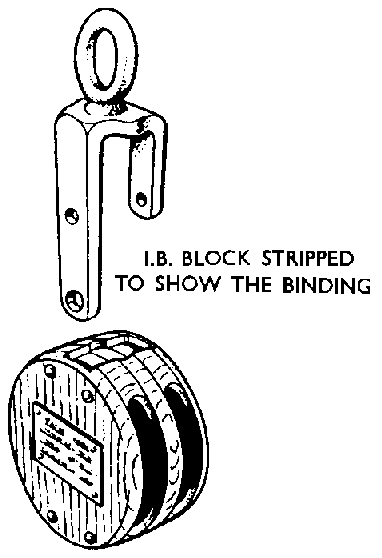
[ FIG. 2. Internal-Bound (I.B.) block ]
Metal Blocks
These blocks are supplied to the Royal Navy and are usually built up of steel plates and fittings. Like the I.B. blocks, their shells have a binding which supplies the strength, but the cheeks, etc., are of light plating. The simplest pattern is the gin block, which consists of a binding carrying one large sheave, and a skeleton rope guard instead of cheeks. Some types of metal blocks, however, have their shells cast in one piece.
Metal blocks vary considerably in quality and finish, the better ones being manufactured for special purposes such as the upper blocks of boats' falls or the blocks of engineers' tackles. Some special-purpose blocks are made entirely of gunmetal or phosphor bronze, which do not corrode as easily as steel when exposed to weather and are not liable to cause sparks when working.
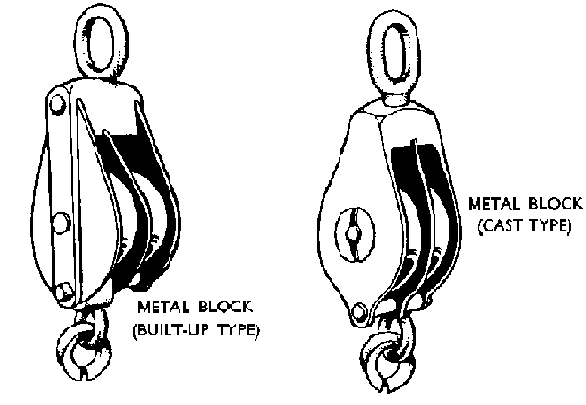
[ FIG. 3. Metal blocks ]
Snatch blocks
These are single blocks, either of metal or internal-bound, in which part of the shell is hinged to allow a bight of rope to be inserted into the swallow from one side. They should not be used when a solid block is suitable for the job. They should NEVER be used when the safety of life depends on them.
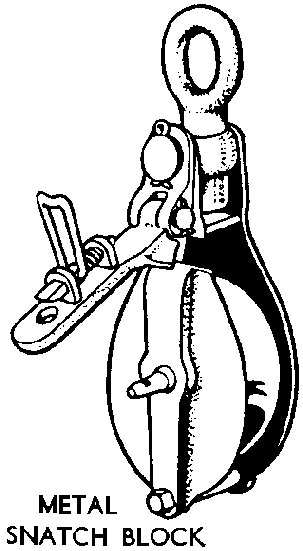
[ FIG. 4. Snatch blocks ]
Common or Stropped blocks
These blocks, which are slowly going out of service, have shells made entirely of elm. They are the oldfashioned type of wooden block, which is held in position by a strop passed round its shell and seized into a thimble-eye at the crown; the strop thus strengthens the shell and the block.
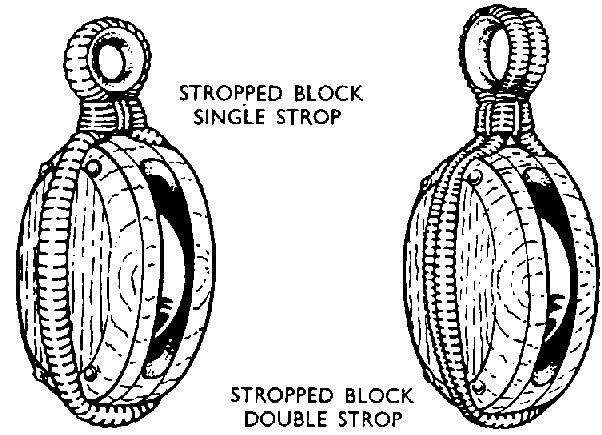
[ FIG. 5. Common or Stropped blocks ]
Clump block
This block can be of wood or metal and it has an exceptionally large swallow. The wooden clump block is made in a similar manner to the common block, but it will take a rope of half its own size; a 6-in clump block, for example, will take a 3-in. rope. Wooden clump blocks are used on lower booms to support the bights of the boat ropes, and metal clump blocks are usually designed to take chain.
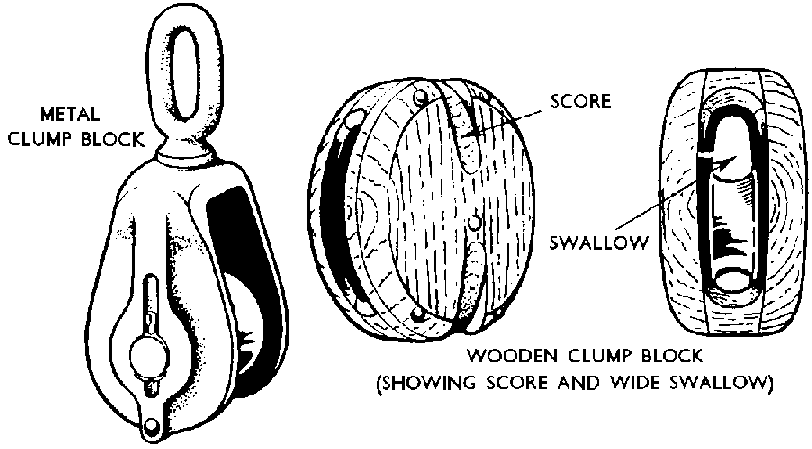
[ FIG. 6. Clump blocks ]
Fiddle blocks.
These are double blocks, usually of metal, in which the sheaves are carried one above the other instead of side by side. Though not supplied in the Royal Navy, they are used in the Merchant Navy where a double block is required but where there is either insufficient lateral room for the normal type or where it is desired to separate the parts of the fall with which the block is rove.
Sheaves and bearings
The sheaves of all wooden blocks are of phosphor bronze, and those of metal blocks are either of phosphor bronze or mild steel. Phosphor bronze sheaves are the more expensive, but are desirable where the blocks are exposed to corrosion, as in boats' falls and engineers' tackles, or where sparking may be dangerous, as in ammunition hoists. The pins of all blocks are of steel.
The bearing between the sheaves and the pin may be of the plain, roller or self-lubricating type. In accordance with common engineering practice a mild steel sheave with a plain bearing has a small brass bush let into its centre to form the bearing, because steel bearing on steel is liable to seize. Roller bearings are fitted in a number of special metal blocks, including most of those used for boats' falls. Self-lubricating bearings have a perforated bronze bush next to the pin, the perforations being filled with a special lubricant. They are used in the Royal Navy for some derricks and in boat-hoisting machinery.
Means of attaching
Every block, except a stropped block, has a fitting at its crown by which to secure it where required. A list of such fittings is given below:
- A standing eye in line with the sheave.
- A standing eye at rightangles to the sheave (reversed).
- A standing eye at rightangles to the sheave, with a free hook
- A swivel eye.
- A swivel hook.
- A swivel eye and a free hook.
- A jaw in line with the sheave.
- A jaw at right angles to the sheave.
Notes
(i) A jaw is a forkshaped fitting by which a block can be suspendedand at the same time kept from turning; it is fitted to the upper blocks of some boats' falls.
(ii) All blocks fitted with a swivel at the crown are called swivel blocks.
(iii) As a general rule 1, 2 and 4 I.B. blocks have an oval eye for which a shackle is required, whereas similar metal blocks have a shackle permanently fixed in the eye.
A block is fully described as follows:
- Size (wooden blocks only).
- Number of sheaves.
- Type (I.B., common, steel, etc.), with details of sheaves sometimes included.
- Size and type of rope (metal blocks only).
- Means of attachment (standing eye, swivel hook, etc.).
- Pattern number.
EXAMPLES:
1. A 12-in., double I.B. block, fitted with swivel ovaleye and becket, pattern 281.
2. A treble steel block with mild steel sheaves for 3-in. cordage, fitted with a standing eye reversed, free hook, becket and thimble, pattern 5124A.
Strength of blocks
In general it can be said that the safe working load of an I.B., a metal, or a common block is stronger than the rope for which it is designed. A snatch block is about one-third of the strength of an I.B. block used for the same size of rope; a clump block is about one-quarter of the strength of such a block. Every block has its safe working load shown on a plate fixed to one cheek.
Tutorial Links
- Traditional Types of Rope
- Purchase and Tackles
- Blocks
- The Beaufort Scale
- Rowing / Pulling
- RYA Standards